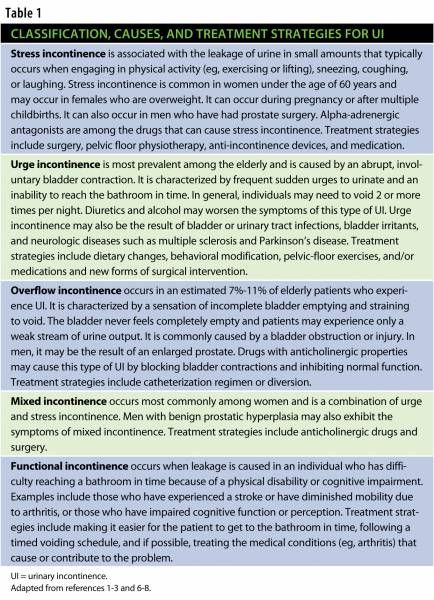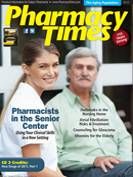Publication
Article
Pharmacy Times
Living with Urinary Incontinence
Author(s):
Pharmacists can recommend products and lifestyle modifications to help patients manage this uncomfortable and embarassing condition.
Pharmacists can recommend products and lifestyle modifications to help patients manage this uncomfortable and embarassing condition.

Urinary incontinence (UI) affects individuals of all ages. Although the prevalence is higher in those 65 years and older, it should be noted that it is not a normal part of the aging process.1-3 Urinary incontinence is a symptom that can be caused by anatomic, physiologic, and pathologic factors that affect the urinary tract, as well as other external factors. 1
The National Association for Continence reports that an estimated 25 million individuals in the United States experience transient or chronic urinary incontinence, with about 85% of the cases affecting women.1-3 As many as 9 to 13 million women experience symptoms which negatively impact their overall quality of life.1,2 Another 34 million individuals 40 years and older who are affected by UI experience various degrees of overactive bladder symptoms or recurring symptoms of urgency and frequency.1,2 Worldwide, UI affects an estimated 200 million individuals. 1,2
Approximately 80% of UI cases can be treated or significantly improved with proper intervention, according to the National Association for Continence.1,2 UI, however, is often underdiagnosed and underreported; more than 50% of individuals affected by bladder disorders rarely, if ever, discuss these issues with their primary health care provider due to fear, embarrassment, denial, and misinformation. 1-4 As a result, UI issues are often left untreated and eventually may negatively impact one’s quality of life.1-4 On average, women wait at least 6.5 years from the first time they experience UI symptoms before they seek a diagnosis for their bladder control issues, and at least two-thirds of those who experience bladder control symptoms do not use any treatment or product to manage their UI.1,2 Many factors have been identified as contributors to UI. Some cases of UI may be classified as transient and are caused by the use of certain medications or by a urinary tract infection, and can therefore be reversed.1-3 However, many UI cases are considered to be chronic and longlasting unless the individual seeks medical evaluation and proper treatment.3,5,6
Treating UI
In general, the 3 main types of treatment for UI are behavioral techniques, use of pharmacologic agents, and surgery. The first step typically entails initiating the least invasive therapy.1-6 Treatment is based upon the type and severity of the UI as well as the patient’s medical and medication history.1-6 Many cases of UI may require a combination of therapies. For those individuals whose UI cannot be cured or for those who are awaiting treatment, a number of devices and products are available that can aid in the management of UI, including catheters, pelvic organ support devices, urethral inserts, external collection systems, and absorbent products.1-5
Pharmacists are likely to encounter patients seeking advice about the treatment of UI and the selection of supplies to help manage the condition. Pharmacists should be prepared to counsel and guide patients and caregivers in the selection of absorbent products. When speaking with patients about UI, pharmacists should always encourage patients to obtain a proper diagnosis from their primary health care provider, as there are different types and different causes of UI.
Patients should also be advised that many cases of UI can be managed and even reversed with proper treatment (Table 11-3,6-8).1 Some causes of temporary incontinence include alcohol use, overhydration, caffeine consumption, bladder irritation, and certain pharmacologic agents (Table 21-3,6). Pharmacists can assist patients by identifying the pharmacologic agents that might contribute to or cause UI, including angiotensin-converting enzyme inhibitors, alpha-adrenergic blockers, antihistamines, calcium channel blockers, diuretics, and antidepressants.1-4
Managing Symptoms
A number of absorbent products are currently available to assist in the absorption of urine, including guards/shields, undergarments, and briefs. These products are available in disposable or reusable form and in a variety of sizes. They can aid in providing a moisture barrier to protect clothes, bedding, and furniture, and also can minimize skin contact with urine. Factors often considered in the selection of these products may include the amount of urine that is typically leaked, the severity and type of UI, the patient’s functional status, the patient’s personal preference, ease of use, cost, and the product’s ability to control odor.1,8 In addition, there are gender-specific products and products designed for overnight use. Disposable cleaning supplies are also available to help protect against skin rashes and irritation. Pharmacists can provide patients with information to help them make informed decisions about the options available for both the treatment and management of UI. They can also encourage patients by reminding them that in the majority of cases, UI can be managed and improved with the proper treatment. PT
Ms. Terrie is a clinical pharmacy writer based in Haymarket, Virginia.
References
1. General prevalence of urinary incontinence. National Association for Continence Web site. www.nafc.org/media/statistics/prevalence-2/. Accessed November 30, 2011.
2. What is incontinence? National Association for Continence Web site. www.nafc.org/bladder-bowel-health/. Accessed November 29, 2011.
3. O’Neil C. Adult urinary incontinence and supplies. In: Berardi R, Newton G, McDermott JH, et al, eds. Handbook of Nonprescription Drugs. 16th ed. Washington, DC: American Pharmacists Association; 2009:947-959.
4. Urinary incontinence in the elderly: types and causes of urinary incontinence. Medscape Web site. www.medscape.com/viewarticle/410843_5. Accessed November 30, 2011.
5. Urinary incontinence. The Merck Manual for Healthcare Professionals Online Edition. www.merckmanuals.com/professional/sec17/ch228/ch228b.html. Accessed November 30, 2011.
6. Vasavada SP, Carmel ME, Rackley R. Urinary incontinence. Medscape Web site. http://emedicine.medscape.com/article/452289-overview. Accessed December 1, 2011.
7. Nadir N. Urinary incontinence. Medscape Web site. http://emedicine.medscape.com/article/778772-overview. Accessed November 29, 2011.
8. Urinary incontinence products. Medline Plus Web site. www.nlm.nih.gov/medlineplus/ency/article/003973.htm. Accessed November 29, 2011.







